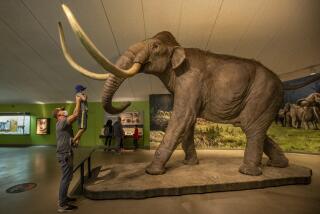Did dinosaur ancestors benefit from worst extinction on Earth?
Dinosaurs may have been wiped out by a mass extinction about 65 million years ago, but an earlier extinction event may have given their predecessors a leg up on the competition, according to a study in Proceedings of the National Academy of Sciences.
Dinosaurs roamed the Earth well after the most devastating die-off in the planetâs history, 252 million years ago at the end of the Permian period. Though researchers donât know exactly what caused the so-called Great Dying, it must have been ugly, because 70% of terrestrial vertebrate species were wiped out.
Researchers had thought that dinosaursâ predecessors hadnât acted quickly enough to fill in the empty ecological niches left after their former occupants were wiped out, because thatâs what the fossil record seemed to show -- particularly in spots like South Africaâs Karoo basin, which was treated as a sort of record of species in southern Pangaea (the super-continent that once contained nearly all the Earthâs landmass).
But now, it turns out that South Africa may not have been the right place to look.
The international team of scientists conducted a thorough search of fossil sites in Tanzania, Zambia and Antarctica and existing fossil collections, showing that the species that survived after the Great Dying were far more fragmentary and isolated than before.
Five million years before the extinction, 35% of four-legged species lived in at least two of five studied locations. But 10 million years afterward, only 7% did.
No longer could some species range a full 1,600 miles, as they did before the Great Dying. Different species were adjusting to dramatic environmental changes in their own local pockets of land. South Africa could no longer be a record for the larger region.
âOur research in the Middle Triassic of Tanzania and Zambia has uncovered an unsuspected taxonomic and ecological diversity of archosaurs,â the authors wrote, âindicating that the Karoo may not serve as a useful model system for understanding postextinction diversification.â
At spots in Tanzania and Zambia, the team found fossil evidence of archosaurs about 10 million years after the Great Dying -- still millions of years before these ancestors of dinosaurs were seen in other spots on Earth. These dinosaur predecessors may indeed have gotten a leg up because of the mass extinction, the authors surmised.
âArchosaurs, which began diversifying in the Early Triassic, were likely beneficiaries of this ecological release and remained dominant for much of the later Mesozoic,â the authors write.
Follow me on Twitter @aminawrite.







